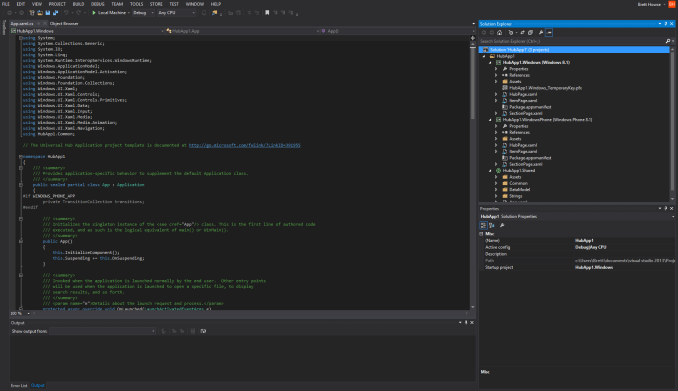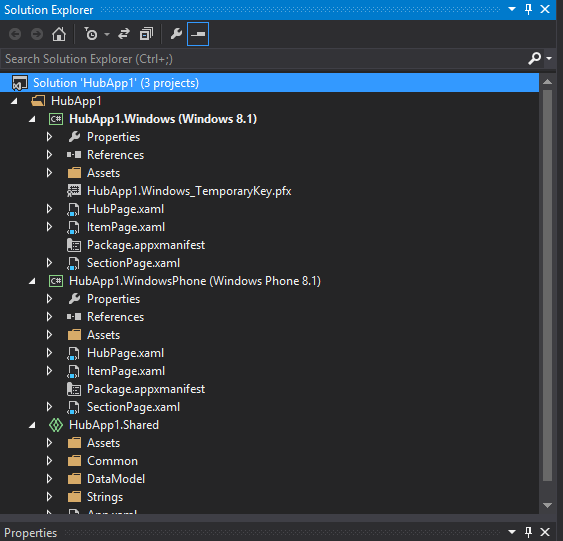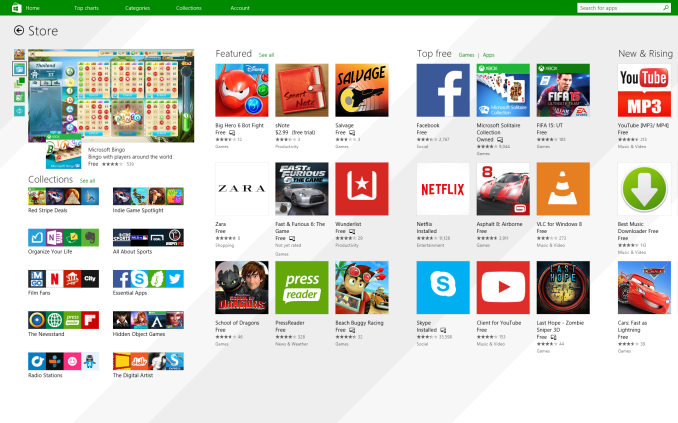Windows 10 Technical Preview First Impressions: The Return Of The Desktop
by Brett Howse on November 13, 2014 8:00 AM EST- Posted in
- Software
- Microsoft
- Windows 10
Universal Apps and the Windows Store
We just got done discussing why a single user interface for the OS across multiple devices is not always the ideal solution, so of course the obvious question with Universal Apps is why would you want it with the app model instead? Thankfully this is not the case although the term Universal App might lead people to believe they are attempting to have a single app target all of their platforms. The truth of the matter is that Universal Apps are Universal in the sense that they share a common app store.
If Microsoft is going to have Windows 10 succeed on desktops, laptops, tablets, phones, and even Xbox One, they need developer buy-in. A platform without apps is not much use to anyone. With the Universal App, they can bridge all of their platforms with a single App in the store. Under the hood, each app is created with a common framework of code, as well as multiple user interfaces in order to tailor the experience to the correct device type. Below is a screenshot of Visual Studio – Microsoft’s developer tools – with a new Universal App about to be created.
 Visual Studio Showing a Universal App Project
Visual Studio Showing a Universal App Project
As you can see, there is a shared portion of code, and then a project for the UI for Windows 8.1, and Windows Phone 8.1. Xbox One is not available yet, but should be added in a future release of Visual Studio.
A close up of the projects
But you may be wondering why any of this is necessary. Windows has the largest selection of applications of any system ever. That is of course true, and the Win32 framework has served both Windows and its users well over the years. But with the new WinRT framework there are some big advantages. First, it can be written to in multiple languages including HTML. WinRT supports C++/CX, C#, VB.NET, and HTML scripting with JavaScript and TypeScript. The security model for WinRT apps is a lot different than Win32, with all WinRT apps running in a sandbox mode for higher security. Unlike apps written in .NET, WinRT is native code, which should result in better performance. Contracts and Extensions are also new to WinRT, and allow apps to share data while still being in a sandbox. One of the biggest advantages of WinRT is that it is DPI aware, and can automatically scale apps appropriately based on screen size and screen resolution. Here, as we know, Win32 apps can struggle even though there are solutions in place.
Adobe Touch WinRT (left) vs Adobe Reader Win32 (right) on HiDPI display
One of the biggest disadvantages of WinRT is that it is only available on Windows 8 and newer devices. With Windows 8 struggling in the market as compared to Windows 7, the user reach of a developer targeting WinRT apps in the Windows Store would be for a subset of the total user base. With Windows 7 having over 50% of the desktop OS market share to itself, this is going to be an issue.
With Windows 10, Microsoft is certainly targeting Windows 7 users. If they can convince them to upgrade to the latest version of the operating system, then the new environment will have a much larger target base and will hopefully encourage developers to target the Windows Store. We have not heard of any upgrade promotions or pricing yet, but this is one of the biggest advantages Apple has had over the years. Their user base generally upgrades the OS at a much faster uptake than Windows. This allows developers to utilize newer APIs in the latest versions of their operating systems and keep the platform progressing. Microsoft has already had to deal with people being stuck on Windows XP, and they must be wanting to avoid that with Windows 7.
Since we are discussing Universal Apps and their advantages, one of the biggest advantages is the Windows Store. With Microsoft hosting the entire download and purchase of all WinRT apps, having user settings and apps sync from one device to another is much easier. One of the greatest experiences with Windows 8.1 is signing into a new PC for the first time. When you log in with your Microsoft Account, the system asks you if you would like to copy the devices and apps from one of your other devices, or if you want to start with a clean machine. If you choose a previous machine, all of the settings, wallpaper, Start Screen layout, and Windows Store apps are synced to the new device. In the case of Windows Store apps, the app itself is listed on your Start Screen, but it is not downloaded until the first time you select it. This avoids a situation where you will significantly delay the initial login time with a massive download, as well as avoid filling the available storage with apps you may not need on that particular device.
Also, like modern tablet and smartphone OSes, WinRT apps from the store are automatically kept up to date by the store. This avoids a lot of the issues with viruses and malware attacking an older version of a product since in theory it will not be around any longer.
The one thing missing from this are the older Win32 apps on the desktop, because they are not available in the Windows Store. Prior to Windows 10, desktop apps could be listed in the store, but the store would then link to the developer’s website to allow you to purchase and install the app. With Windows 10, rumors are that desktop apps will also be available and managed through the Windows Store. Assuming this does happen, then this will be a major boon to users. Desktop apps should in theory also be able to be kept up to date using the Windows Store which should cut back on the number of outdated pieces of software targeted by malware.
The Windows Store is a key piece of Windows 10. Universal Apps can be made available for multiple platforms through the store, and, if the rumors are true, even desktop apps will be available through the store. This should make the Out Of Box Experience (OOBE) very good for users with a Microsoft Account. The WinRT framework has not yet had the killer app written for it, so hopefully with Windows 10 the framework will be expanded to allow for more powerful apps to be created.













198 Comments
View All Comments
JonnyDough - Friday, January 16, 2015 - link
Microsoft will just force you to switch as they did before. They will drop support and remove updates from the internet so that you can't even patch your old OS to last year's security level.CaedenV - Thursday, November 13, 2014 - link
I have been playing with 10 in a VM on my desktop off and on, and it has been pretty awesome so far. I do wish they would have gone with something more like the WP Start menu and give the option between that and the 'traditional' win7 style menu rather than having tiles endlessly (and annoyingly) sprawl off to the right, but outside of that everything else has run very smoothly.Can't wait for winter break when I will be able to risk installing on my Dell XPS12 to get a feel for the touch and form factor switching capabilities of continuum. That is what is going to make or break this version for mainstream users (who by in large like win8.1). But for business and pro use win10 is already going to be a big step forward compared to 8.
kamm2 - Thursday, November 13, 2014 - link
I know so many people who will not buy Windows 8 computers because of two reasons. The Start screen is one even though I tell people they can install a free app to get the W7 start menu back. The second being that W8 is ugly. From what I've seen this will still be an issue with W10.darthrevan13 - Thursday, November 13, 2014 - link
Flat is the new trend on the web because of everything now need to be responsive to the screen size/window size. Android and iOS became more flatter because of that. If you're hoping for Win 7 style Aero 3D effects then I think you're going to be dissapointed by all OSes, except Linux perhaps, if you have the time to invest customizing your interface.kamm2 - Thursday, November 13, 2014 - link
There is a lot that can be done between the two and flattening an interface does not necessarily mean it has to look ugly. Less appealing to some sure but there are ways to minimize that. iOS 8 and Lollipop does not stir up such a strong dislike. It also doesn't help sales that whenever a W8 device is displayed in an ad there's that loathed start screen staring at you.kyuu - Friday, November 14, 2014 - link
Funny, I think iOS8 is a pretty horrid mishmash of iOS's chiclet-tiles on a grid with modern flat design principles that ends up being pretty ugly. Lollipop simply makes Android look a lot more like Windows 8, really. They certainly did a better job of going flat than Apple did.And I really, really don't get the hate for the start screen's aesthetics. In what way is it worse than iOS and Android's tiles-on-a-grid?
steven75 - Friday, November 14, 2014 - link
It's purely subjective. It just happens to be that you are very much in the minority. Nothing wrong with that.GuardianAngel470 - Saturday, November 15, 2014 - link
Two reasons: 1) Color Clash. Any half-way fashion/home design/color design-conscious person can tell you that some colors should simply not show up next to each other.Windows Phone 7 (the grandfather of ModernUI) didn't have this problem. It had a unified color interface; you picked your color, and all buttons on the start screen were that color. Occasionally some apps would change on you depending on their activity, but the buttons were typically all the color you chose for them.
Windows 8 changed that. Boot up the computer for the first time and you're confronted with half a dozen different pastel colors, many of which clash horribly. It's like looking at a hip woman from the 80's; complete color-induced eyestrain.
2) Massive wasted space. This is an issue I personally have with it, and I'm not sure if anyone else does. Essentially, on a 24+ inch monitor, Windows 8 wastes massive amounts of space. Huge swaths of the Start Screen are just a solid color background. Most of the app buttons are empty space. Apps themselves (back when they were fullscreen by default) had about a 3 to 1 ratio of unused space to relevant info/interface.
Personally, I HATE that. Maybe it's just OCD of me, but I hate wasting space like that. It's physically irritating when it does that. That I couldn't stop it was even worse.
8.1 didn't really help with that either.
inighthawki - Thursday, November 13, 2014 - link
"because of everything now need to be responsive to the screen size/window size"That's funny, I haven't had this issue since... oh wait, never. Windows 7 works great. Flat graphics is a horrible invention of the web because web sites needed to be performant on extremely low end devices (because html, js, and CSS are garbage for performance compared to native code and hardware accelerated graphics), and low bandwidth connections. A desktop OS does not really have these issues. The windows desktop is fully composed using hardware acceleration on a heavily optimized compositor that supports things like occlusion.
kyuu - Friday, November 14, 2014 - link
Except that flat design has nothing to do with performance considerations. This is something that you (and a lot of other people) are essentially making up. Flat design is simply the way design is currently moving -- it's a break from the previous skeumorphism-heavy design ethos. It's a design choice, not a technical consideration. Any performance benefit (from not having to render fake-3D effects and transparencies) is merely tangential.